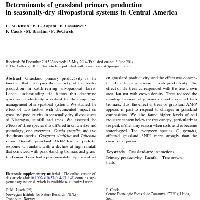Resumen
-
Grassland primary productivity is the function that underpins the majority of the fodder production in cattle-rearing silvopastoral farms. Hence, understanding the factors that determine grassland productivity is critical for the design and management of silvpastoral systems. We studied the effect of two factors with documented impact on grassland productivity in seasonally dry silvopastures of Nicaragua, rainfall and trees. We assessed the effects of three species that differed in crown size and phenology, one evergreen, Cassia grandis, and two deciduous species, Guazuma ulmifolia and Tabebuia rosea. Overall, grassland ANPP had a quadratic response to rainfall, with a decline at high rainfall that coincided with peak standing biomass and grassland cover. Trees had a predominately negative effect on grassland productivity, and the effect was concentrated in the rainy season at peak productivity. The effect of the trees corresponded with the tree crown area, but not with crown density. Trees reduced the standing biomass of graminoids and increased forb biomass; thus, the effect of trees on grassland ANPP appears in part to respond to changes in grassland composition. We also found higher levels of soil moisture content below the tree canopy, particularly at the peak of the rainy season when soils tend to become waterlogged. The evergreen species, C. grandis, affected grassland ANPP more strongly than the deciduous species.
